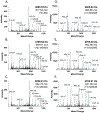Exploring the Diversity of Cysteine-Rich Natural Product Peptides via MS/MS Fingerprint Ions
- PMID: 32872784
- PMCID: PMC7816094
- DOI: 10.1021/jasms.0c00078
Exploring the Diversity of Cysteine-Rich Natural Product Peptides via MS/MS Fingerprint Ions
Abstract
Natural product extracts present inherently complex matrices in which the identification of novel bioactive peptide species is challenged by low-abundance masses and significant structural and sequence diversity. Additionally, discovery efforts often result in the re-identification of known compounds, where modifications derived in vivo or during sample handling may obscure true sequence identity. Herein, we identify mass spectral (MS2) "fingerprint" ions characteristic of cyclotides, a diverse and biologically active family of botanical cysteine-rich peptides, based on regions of high sequence homology. We couple mass shift analysis with MS2 spectral fingerprint ions cross referenced with CyBase-a cyclotide database-to discern unique mass species in Viola communis extracts from mass species that are likely already characterized and those with common modifications. The approach is extended to a related class of cysteine-rich peptides, the trypsin inhibitors, using the characterized botanical species Lagenaria siceraria. Coupling the observation of highly abundant MS2 ions with mass shift analysis, we identify a new set of small, highly disulfide-bound cysteine-rich L. siceraria peptides.
Figures




References
-
- Pirtskhalava M; Gabrielian A; Cruz P; Griggs HL; Squires RB; Hurt DE; Grigolava M; Chubinidze M; Gogoladze G; Vishnepolsky B; Alekseyev V; Rosenthal A; Tartakovsky M DBAASP v.2: an enhanced database of structure and antimicrobial/cytotoxic activity of natural and synthetic peptides. Nucleic Acids Res 2016, 44, D1104–1112. - PMC - PubMed
-
- Kumari G; Serra A; Shin J; Nguyen PQ; Sze SK; Yoon HS; Tam JP Cysteine-Rich Peptide Family with Unusual Disulfide Connectivity from Jasminum sambac. J Nat Prod 2015, 78, 2791–2799. - PubMed
-
- Marshall E; Costa LM; Gutierrez-Marcos J Cysteine-rich peptides (CRPs) mediate diverse aspects of cell-cell communication in plant reproduction and development. J Exp Bot 2011, 62, 1677–1686. - PubMed
MeSH terms
Substances
Grants and funding
LinkOut - more resources
Full Text Sources
Other Literature Sources
Molecular Biology Databases

